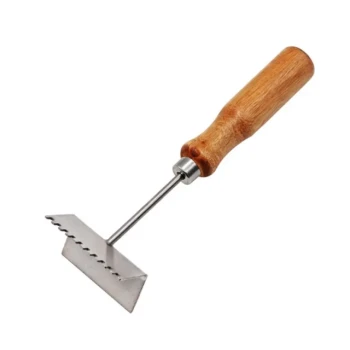For effective sting protection, a beekeeping suit must excel in three core areas: the material itself, the construction of its closures, and the integrity of its entry points. The best suits combine thick, multi-layered fabric with high-quality zippers, reinforced seams, and tight-fitting elastic cuffs to create an impenetrable barrier against stinging insects.
The primary goal of a beekeeping suit is not just to be thick, but to create a complete and unbroken seal. A suit's true protective value is determined by the integrity of its weakest points—the cuffs, zippers, and veil connection.

The Anatomy of a Sting-Proof Suit
Think of your suit not as clothing, but as personal protective equipment. Each feature is a component in a system designed to keep you safe and confident, allowing you to focus on the health of your hive.
The First Line of Defense: Fabric and Layering
The suit's material is what stands between you and a bee's stinger. A stinger needs a certain depth to penetrate and deliver venom effectively.
Modern suits use fabric thickness and multiple layers to defeat this mechanism. Some suits use thick, traditional cotton, while many newer designs feature triple-layer mesh constructions. This mesh creates a significant gap that a stinger simply cannot bridge.
Critical Entry Points: Zippers and Seams
A high-quality fabric is useless if a bee can crawl through an opening. Zippers are a common point of failure on lower-quality suits.
Look for suits with heavy-duty zippers that feature overlapping fabric flaps. This design prevents bees from gaining access through the zipper teeth. Likewise, well-sealed or reinforced seams ensure there are no small gaps for a determined bee to exploit.
The Final Seal: Cuffs and Closures
The most common places for bees to enter a suit are the wrists and ankles. Once inside, a single bee can cause significant disruption and multiple stings.
Elastic cuffs at the wrists and ankles are a non-negotiable feature. They must be snug enough to form a complete seal around your gloves and boots, effectively blocking any potential access routes for insects.
Essential Visibility and Protection: The Veil
The head and face are the most critical areas to protect. A suit's hooded veil is an integral part of its protective system.
The veil must attach securely to the suit's collar, often with a zipper, to eliminate any gaps around the neck. A quality veil provides clear visibility while ensuring no insect can reach your face.
Understanding the Trade-offs: Protection vs. Comfort
Choosing a suit involves balancing absolute protection with practical usability. The safest suit is worthless if it's too uncomfortable to wear during an inspection.
Thickness and Breathability
A thicker suit provides more protection, but it also traps more heat. Working in a heavy cotton suit on a hot day can be exhausting and lead to overheating.
This is why ventilated, multi-layer mesh suits have become so popular. They offer excellent sting protection by creating distance while allowing for significantly better airflow, keeping the beekeeper cool and focused.
Security and Mobility
More layers, thicker materials, and reinforced sections add up to a heavier and bulkier suit. This can sometimes restrict movement, making delicate hive manipulations more difficult.
The ideal suit offers robust protection without feeling overly cumbersome, allowing you to move naturally and confidently.
Selecting the Right Suit for Your Needs
Your choice should be guided by your climate, the temperament of your bees, and the frequency of your hive inspections.
- If you are a hobbyist with infrequent inspections: A quality, thick cotton suit with secure elastic cuffs and a reliable veil system is often a sufficient and cost-effective choice.
- If you work in a hot climate or inspect hives frequently: Prioritize a ventilated, triple-layer mesh suit to ensure comfort and prevent overheating during long sessions.
- If your top priority is maximum security (e.g., working with aggressive hives): Choose the most robust, reinforced suit available and accept the potential trade-off in weight and ventilation.
A well-chosen suit empowers you to be a calm, confident, and effective beekeeper.
Summary Table:
| Feature | Purpose | Key Considerations |
|---|---|---|
| Fabric & Layering | Block stinger penetration | Thick cotton or triple-layer mesh for depth and breathability |
| Zippers & Seams | Prevent entry through gaps | Heavy-duty zippers with fabric flaps; reinforced seams |
| Cuffs & Closures | Seal wrists/ankles | Snug elastic cuffs to block access points |
| Veil & Hood | Protect face and neck | Secure zipper attachment to suit; clear visibility |
| Protection vs. Comfort | Balance safety and usability | Ventilated mesh for hot climates; reinforced suits for aggressive hives |
Ready to equip yourself with a suit that offers uncompromising sting protection? At HONESTBEE, we specialize in supplying durable, high-performance beekeeping suits and equipment tailored for commercial apiaries and distributors. Our suits are engineered with triple-layer mesh, reinforced closures, and secure veils to keep you safe and comfortable during long hive inspections. Contact our wholesale team today to discuss bulk pricing and find the perfect protective gear for your operation!
Visual Guide

Related Products
- 3 Layer Mesh Vented Sting Proof Beekeeping Suit with Hat and Veil
- Cotton Beekeeping Suit and Round Hat with Veil Bee Keeper Protective Gear
- Vented Beekeeping Jacket with Hood and Veil for Beekeepers
- Yellow Plastic Bucket Pail Perch for Beekeeping
- Heavy-Duty Stainless Steel Clip-On Frame Perch
People Also Ask
- What are the key features of the 3-layer mesh gear designed for beekeeping? Superior Protection & Ventilation
- What should be worn under beekeeping protective clothing? Maximize Your Safety with the Right Base Layer
- What should be considered when fitting beekeeping clothing? The Essential Guide to Safety & Comfort
- What are the key features to look for in beekeeping clothing? Ensure Maximum Safety & Comfort
- What are the benefits of a fully ventilated beekeeping suit? Stay Cool and Protected in Hot Climates



















